Eflad (Pacifica)
Republic of Eflad Republik Eflad (Efladian Alman) | |
|---|---|
Motto: "Per apsera ad astra" "Through hardships to the stars" | |
Anthem: Das Land der Wälder Land of the forests | |
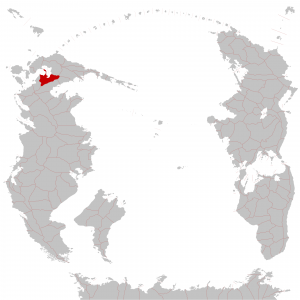 Location of Eflad in the South Pacific | |
| Location | Northwest of Cordilia, at the Astro sea |
| Capital | Münnen |
| Largest city | Münnen |
| Official languages | none |
| Recognised national languages | Low Alman, Efladian Alman, Austral |
| Demonym(s) | Efladian |
| Government | Federal parliamentary republic |
| Dr. Gerno Efæn | |
| Hanna Tirng | |
| Föderales Konzil | |
| Sænat | |
| Formation including major divisions | |
• Kingdom of Freedort | 950 BCE |
• Duchy of Lordgad | 936 BCE |
• Kingdom of Sworen | 929 BCE |
• Kingdom of Eflad | 28.02./01.03.1165 CE |
• Republic of Eflad | 23. August 1840 |
• Technocratic Republic of Eflad | 23. August 1972 |
• Republic of Eflad | 20. August 2022 |
| Area | |
• Total | 152,827 km2 (59,007 sq mi) (18) |
| Population | |
• 2020 census | 56,701,563 (14) |
• Density | 327/km2 (846.9/sq mi) (7) |
| GDP (nominal) | 2020 estimate |
• Total | $2,272 billion |
• Per capita | $40,070.55 |
| Gini (2019) | 20.54 low |
| HDI (2019) | 0.922 very high |
| Currency | Gras (EDG) |
| Time zone | UTC-2 (CCT) |
| Date format | dd/mm/yyyy |
| Mains electricity | 230V - 50Hz |
| Driving side | right |
| Calling code | +693 |
| World Forum Code | ED |
| Internet TLD | .ed |
Eflad (pronounced: /eflɑːd/, Low Alman: /eflɑːd/), officially the Republic of Eflad, is a country in the South Pacific on the island of North Cordilia. Eflad is situated between the Astro Sea and Berusturg and the Groot Brocken mountain range, bordered by Berusturg to the north, Besern to the east, Koros to the south, and EAS to the south-west. Characteristic for Eflad and the Ares Island, situated in the Astro Sea, are their rainforests with a humid summer tropical rainforest climate, their coastal and urban regions, and their steep mountains. Eflad has a total area of 152,827 km2 and a population of 56 million (as of 2021). Eflad is a federal parliamentary republic. [1] The capital is the city of Münnen, the country's largest city and main cultural and scientific centre. Other major cities are Selpe, Krœfed and Cræfoi.
Eflad has been inhabited for a long time. Oldest remains indicate that during the emigration wave in 20 000 BC, Eflad was a route towards south Cordilia. Due to its vast valleys and rainforests, it was seen as a resourceful place to settle. Later on, the first Efladian tribes were established. Today named Laertans, they were the first permanent settlers, which shaped Eflad's geography to their needs. A particularly prosperous part of Eflad was what today are Fredoast and Lorgder, due to their favourable position with Eflad's largest rivers, Sapol, Rite, Kerta, and Reitë.
Various Efladian tribes have inhabited the Efladian mainland. A region called Eflaert was documented before 30 CE. In 950 BCE, the Kingdom of Freedort was established, consisting of several small duchies. During the same time, in 936 BCE, tribes in Lordgad, modern-day Lorgder, founded the Duchy of Lordgad. Similarly, the Kingdom of Sworen was established in the north in 929 BCE. In the Treaty at the River Joint, the two kingdoms and the duchy decide to unite due to dangers abroad, founding the Kingdom of Eflad. After initial contact with the Gianlucan Empire in the 14th century, the kingdom was first made dependent by the Gianlucans and then colonised through the installation of an Gianlucan king without a lot of resistance due to the technological advantage of the colonisers. The natives were soon enslaved and driven out of their homes to make room for the Gianlucian. After several centuries of Gianlucian rule, the Efladians decided to revolt against the Gianlucan empire. The coup d'etat resulted in the Efladian Revolution, which ended the Gianlucan rule in Eflad and established the Republic of Eflad.
Etymology
The name Eflad derives from the Efladian Ef-lae-ert, meaning "land of the forests", which was documented by early Gianlucian settlers. The earliest record of the name Ef-lae-ert was documented in 1392 during first contact with the Gianlucians.
Geography
Eflad is situated between the Astro Sea in the northwest and a mountain range in the south and east. Elevation ranges from Mt. Tlohog (2167m) to the valley, which lies just above the level of the sea (65m). Significant natural resources are copper, silicium, and uranium. The plains of Efald are mostly covered in rainforest, although a large portion has been cut down due to urban expansion.
Eflad is the twenty-seventh-largest country in the South Pacific; bordering Berusturg to the north, Besern to the east, Koros to the south, and EAS to the south-west. Eflad is also bordered by the Astro Sea. Efladian territory covers 152,827km2 (59,007 sq mi). Elevation ranges from the mountains of the Tlohog range (highest point: the Mt. Tlohog at 2.167 metres or 7,110 feet) in the east to the shores of the Astro Sea in the west. The forested mainlands of central and eastern Eflad and the lowlands of western Eflad (lowest point: in the municipality Selpe, Eierwerf at 9,54metres or 31,3 feet above sea level) are traversed by such major rivers as the Sapol, Rite, Kerta, and Reitë. Significant natural resources include silicon and iron ore, coal, Efladian mahogany, uranium, copper, natural gas, salt, and nickel.
Climate
Eflad has a tropical rainforest climate. Winters are usually pretty warm, with the average temperature during the last 15 years was 19°C. The summer is often hot and humid, with temperatures ranging between 30°c and 35°C and humidity ranges between 70% and 95%. The northern regions have prevailing westerly winds that bring in moist air from the North Sea, moderating the temperature and increasing precipitation. Conversely, the southeast regions have more extreme temperatures.
Biodiversity
Many species of birds and mammals found in Eflad have close genetic links with corresponding species found in Gianatla. Eflad is a mega-diverse country.
The Efladian territory can be divided into three terrestrial ecoregions: Astroic mixed forests, Central -, and Eastern Efladian rain- and mixed forests. As of 2019 37% of Eflad's land area is devoted to agriculture, while 40% is forested and 23% is covered by settlements or infrastructure.
History
Early history
The earliest human remains have been found north-east of Reræ and were dated to 20 000 BC. The remains are attributed to one of the migration waves from the Rainbow Islands. Due to findings in other countries that date the remains back as far as 45 000 BCE, it is believed that there are older artefacts to be found on Efladian territory. The migration wave in 20.000 BCE introduced human life to uninhabited Eflad. Its warm climate all year around probably appealed to the early humans. The rain-forests and their agrarian potential, as well as the nutrient-rich soil, contributed to the settlement of Eflad. The first recorded settlement was what later became the city of Selpe. The oldest remains of this settlement date back to 12 000 BCE. The city was structured around the delta of the Sapol River, which meant many smaller settlements distributed around the river and on smaller islands on the river itself. The first laws on Efladian soil were written on a bronze plaque in Selpe, approximately in the 16th century BCE, which has been preserved since. In the following centuries, settlements on current Efladian territory were founded, independent from each other.
First countries (950 BCE - 141 CE)
After centuries of loose states and federations, in 950 BCE the Kingdom of Freedort was founded in Selpe. Its territory spread along the entire length of the Sapol River and beyond. The crowning of the first king is well documented, although in an unintelligible language. Only several passages have been translated. The loss of the native Efladian language occurred during the colonial rule of the Gianlucans, which actively suppressed and destroyed native Efladian culture. Eflad is one of the few still known words. Not long after, in the city further east, the Duchy of Lordgad was founded in 936 BCE, dividing Eflad in two. The northern territories were actively pushing back against the Duchy, finally founding the Kingdom of Sworen in 929 BCE. After being isolated from each other due to the small expanse of territory and strong rebellion from distant villages, the first contact between the Kingdom of Freedort and the Duchy of Lorgded was somewhere between 7 and 10 CE, since sources are not clear. There is no record of first contact between the Duchy and the Kingdom of Swoern (formerly Sworen; see: Writing mistake of Cræfoi). Only letters were found that showed correspondence between the two leaders. At first, the relationships between all states were fairly peaceful. This is due to the focus on expansion in other regions. After the incident at the Rite River spring, the relationship between the Kingdom of Freedort and the Duchy of Lorgder deteriorated rapidly. The situation escalated in 45 CE, when war broke out between Freedort and Lorgder. After a fairly easy fight, the forces of Freedort laid siege to what is today known as Münnen. Due to a harsh winter that year, no further advancements were made by any army, resulting in an armistice and finally a peace agreement with Freedort keeping the majority of their advancements. After several years, in around 130 CE, tensions between the now Kingdom of Fredost and the now Kingdom of Sweorn escalated into a war that lasted 111 years. 65 years into the war, the Duchy of Lorgded joined Sweorn against the Fredost forces. The war resulted in a major loss of territory for Fredost, and a new power structure was established with the Duchy and the Kingdom of Sweorn, creating a loose confederation.
(Early) Middle Ages (300 - 1478)
No wars were fought for a century. At around 300 CE, the then Kingdom of Fredost had an internal power struggle due to the fact that twins were born as heirs to the throne and no birthtime was registered, making both the eldest and apparent heirs. Due to the early death of their father, their mother was queen for a brief period of 15 years. To decide who would assume the throne, their mother proposed a duel. After facing each other, both brothers threw their swords and decided to share the throne in an unprecedented move. This shared reign, however, did not last for long. After six years, the question of who was the older brother was solved by the discovery of a document issued, which then went missing. The younger brother was then stripped of his powers. The years between 325 and 930 CE are ce to the lack of information. The artefacts from this talled the Efladian Dark Ages duime were either destroyed in wars or during the colonial rule of the Gianlucans. After several wars between the three countries, in 1165 CE the two kings and the archduke met at the base of today's Mt. Tlohog and signed the Treaty of Unification, creating the Kingdom of Eflad, the first ever state engulfing the whole Efladian territory. The exact date of the meeting and the signing is not known, as the original document has the date inscribed, which corresponds to the 29th of February, 1165 in Austral. This date, however, is not possible due to the fact that 1165 CE didn't have a 29th of February. This makes the founding date either the 28th of February or the 1st of March. The Kingdom of Eflad was divided into three duchies. The obvious problem was who would assume the throne. Because none of the three parties would vote for the other one, the choice finally fell to the 35 local dukes. The first King of Eflad was the Duke of Lorgded, as the former duchy was represented by 40% of the local dukes, meaning that the Duke only had to convince four other dukes to vote for him. To ensure they stayed in power, the treaty had a clause that said the next heir to the throne was to be the King of Sweorn and then the King of Fredost after the death of the Duke of Lorgded. After their deaths, the heir to the throne would always change between these three royal houses (the Royal Rotation System). This system worked until the renamed houses of the House of Fredoast and House of Lorgder were united through marriage in 1271, creating the House of Fredoast-Lorgder. In 1302, the final unification through marriage was conducted, officially creating the House of Fredoast-Lorgder-Sweori, which was renamed to House of Eflad after two months, creating the first ever fully Efladian royal house. The first King of Eflad of the House of Eflad was Wellen I., crowned in 1320. He ruled for 45 years until 1365, after which his son Wellen II took power. He was the shortest ruling king, as his reign lasted only six years due to his illnesses and early death. Wellen III ruled for 35 years. Under his rule, Eflad saw a significant rise in population due to the distribution of land rights and, consequently, a surge in agricultural production. The first contact with the Gianlucian Kingdom was in 1388, under his rule. After initiating trade deals with the Gianlucians that were profitable to Eflad, the contact deteriorated due to the fact that the Gianlucians demanded further collaboration, which the King denied. He died in 1406 and left the throne to Rekan I., the last king of Eflad. Under his rule, the Efladian army annexed the Ares Island. Twenty-four years into his reign, Eflad made a new trade deal with the Gianlucians, this time benefiting from them rather than the Efladians. Time after time, there were conflicts between the Efladians and the Gianlucian, who brokered a deal with the King giving them the right to settle on Efladian land. In 1478, terminally ill and wanting to prevent an all-out invasion, the last king of Eflad signed his abdication in favour the first Gianlucian king of Eflad, who made Eflad a province of the Empire.
Colonial Rule (1478 - 1839)
During the colonial rule that stretched from 1478, the abdication, until 1840, the Efladian Revolution, Eflad underwent a colossal change. It was made a province in the Gianlucian Empire. However, while the tax rate in all other provinces was 50%, Eflad had to give up 75% of its income on top of having to export most of its agricultural yield, making the province suffer. The national sentiment was achieving new heights and rebellion was a real danger. To solve both problems at once, in 1652 the Gianlucian court passed a law proposed by the Efladian governor Hannes I., classifying indigenous people of the imperial provinces and colonies as possible substitute to monetary taxes. Especially in the Efladian Kingdom a large hunt for all native began, as they could now be used as free labour. The Efladian kingdom itself was participating in the slave business, loaning slaves to the farm owners for a certain sum of money, depending on the farm's capacity. Many slaves were shipped to the Gianlucians as free labour and for economic profit. During Gianlucian reign, a huge majority of native artifacts and historic books were destroyed in order to replace Efladian culture with an Gianlucian one. The Efladian language was forbidden, and the Low Alman was instituted as the official language of Eflad. In organised attacks, whole libraries were destroyed in order to eradicate the Efladian culture. Artefacts could only be preserved through the heroic actions of individuals who hid them from the local institutions.
Efladian Revolution (1839 - 1840)
After centuries of rather calm slavery, multiple localities were having trouble with revolting slaves. In the 1830s, multiple larger revolutions were struck down by state power. Over 4000 slaves died during what are called the Bloody 30s. In 1838, a group of escaped slaves formed in Münnen, one of the cities tolerating fugitive slaves. They acquired weapons for other groups that formed around the country. They were commonly known as the Münnen Group. After arming many fellow natives and awaiting a change in the zeitgeist, they developed a plan to overthrow the Gianlucian king. After establishing multiple chapters in all larger cities, the main group focused on Münnen and the Royal Castle. On the 20th of August, a fight broke out in the city centre that involved one of the Münnen Group members. After accidentally making the previously fixed sign, the other members misinterpreted the sign and started the operation. After the designated messengers to other cities were sent, no return was possible. The Liberation Forces occupied the royal castle, capturing the king famously in the middle of a private act with the queen. The story goes that they were offered to continue only if they were to do it on the main square of the city. Almost all of the high-ranking generals were captured. The remaining ones formed the National Front, fighting in the name of the King. The revolutionaries formed a provisional government. The main goal was now to control all of Eflad's territory. After almost a whole year, all major territories of the National Front were captured. On the 10th of August, the army command signed the unconditional surrender. Thirteen days later, on the 23rd of August, the Republic of Eflad was proclaimed. Internal struggles meant that the already worked out constitution was first implemented four months after the proclamation. The constitution marks the end of century-long supression and enslavement of the indigenous population of Eflad.
Modern Age (1840 - today)
With the establishment of the Republic of Eflad as a democracy, the first Senate elections were held in June 1841. Due to the zero percent hurdle, the first Senate encompassed a lot of political parties representing a vast spectrum. The first Prime Minister of Eflad was Terek Mark Lawlwen. The goal of the first government was the emancipation and integration of the native population into society. To achieve this, the ministry of interior created an exhaustive list of enslaved natives and slaveholders. The moderate part of the government was supporting the idea of accepting the Gianlucian Almans as Efladians. The radical part of the government wanted to strip them of several rights and pursue a course of radical wealth redistribution. The moderate part won the fight in the end, and alman settlers were recognised as Efladian citizens. The government did, however, redistribute wealth, although not in the radical way proposed by the more radical wing.
Eflad transferred from an agrarian society into an industrial one following the industrial revolution. Due to the increase in the living standard, Eflad saw a surge in the birth rate and, due to the advancements in medicine, a decrease in infant mortality. In the following century, Eflad established itself as an industrialised country and a regional power. The industrial revolution caused the development of the social question, which was in part solved by laws creating universal health, working, and labour insurances.
Great War in Eflad (1949-1955)
Eflad was part of the Allies in the Great War. It was partly conquered by the Frankist Empire during the war. The liberation was undertaken by partisans, who freed the occupied territory and thereby seized power over the whole Efladian territory.
The Cold War and the Technocratic Republic of Eflad (1972-2022)
Republic of Eflad (2022-today)
Politics
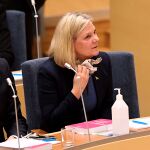
Eflad is a federal, parliamentary, representative democratic republic. Federal legislative power is vested in the parliament, consisting of the Sænat and Föderales Konzil of Eflad (the Federal Council), which together form the legislative body. The Sænat is elected through direct elections using the mixed-member proportional representation system. The members of the Federal Council represent and are appointed by the governments of the four federated provinces. The Efladian political system operates under a framework laid out in the 1954 constitution known as the Verfassung. Amendments generally require a two-thirds majority of both the Sænat and the Federal Council; the fundamental principles of the constitution, as expressed in the articles guaranteeing human dignity, the separation of powers, the federal structure, and the rule of law, are valid in perpetuity.
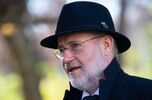
The President of Eflad, currently Dr. Gerno Efæn, is the head of state and invested primarily with representative responsibilities and powers. He is elected by the Föderales Forum (Federal Forum), an institution consisting of the members of the Sænat and Föderales Konzil and representatives from each of the federal provinces. The second-highest official in the Efladian order of precedence is the Sænatsführer ("Sænat leader"), who is elected by the Sænat and responsible for overseeing the daily sessions of the body. The third-highest official and head of government is the Prime Minister, who is appointed by the President after being elected by the party or coalition with the most seats in the Sænat. The Prime Minister, currently Hanna Tirng, is the head of government and exercises executive power through their Cabinet.
Since 1955, the party system has been dominated by the Socialist Party, the Technocratic Eflad, and the now-defunct Conservative Party. So far, every Prime Minister has been a member of one of these parties. In the 2019 Efladian federal election, the right-wing populist Freedom for Eflad gained enough votes to attain representation in the parliament for the first time; however, they missed the five percent hurdle in 2022. Instead, a new protest party called Reform Eflad! managed to win enough seats to form a coalition with the Greens and the Liberals for Eflad. On April 2, 2023, a new party was founded after several protests: the Democratic Union. It has been considered a thematic successor to the Conservative Party. On April 9, 2023, members of the group Moderate Linke (Moderate Left) of the SPE left the party and formed the Social Democratic Party of Eflad (SDP). After the Sænat sitting on April 12, 2023, 30 members of the SPE faction walked over to form the Faction Social Democratic Party together with 24 members of the Techocratic faction who walked over to form the Faction Democratic Union.
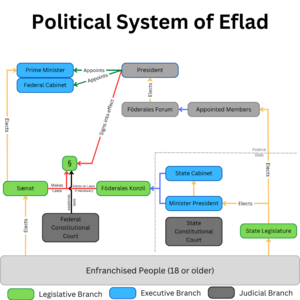
Constituent provinces
Eflad is a federation and comprises four constituent provinces which are collectively referred to as Provinzen. Each province has its own constitution, and is largely autonomous in regard to its internal organisation. As of 2018 Eflad is divided into 278 districts (Kreise) at a municipal level; these consist of 203 rural districts and 75 urban districts.
|
Law
Eflad has a civil law system based on Alman law. The Bundesverfassungsgericht (Federal Constitutional Court) is the Efladian Supreme Court responsible for constitutional matters, with power of judicial review. Eflad's supreme court system is specialised: for civil and criminal cases, the highest court of appeal is the inquisitorial Federal Court of Justice, and for other affairs the courts are the Federal Labour Court, the Federal Social Court, the Federal Fiscal Court and the Federal Administrative Court.
Criminal and private laws are codified on the national level in the Strafgesetzbuch and the Bürgerliches Gesetzbuch respectively. The Efladian penal system seeks the rehabilitation of the criminal and the protection of the public. Except for petty crimes, which are tried before a single professional judge, and serious political crimes, all charges are tried before mixed tribunals on which lay judges (Schöffen) sit side by side with professional judges.
Foreign relations
Traditionally, Eflad avoids alliances that might entail military, political, or direct economic action and has been neutral since the end of its revolution in 1840. Efladian neutrality has been questioned at times. In 2021 Eflad became a full member of the World Forum. Eflad maintains diplomatic relations with almost all countries and historically has served as an intermediary between other states. Eflad is a member of the North Cordilian Union.
Military
Eflad's military, the Efladische Armee (Efladian Armed Forces), is organised into the Heer (Army and special forces), Marine (Navy), Luftwaffe (Air Force), Cyber- und Informationsraum (Cyber and Information Domain Service) branches. In absolute terms, Efladian military expenditure is the sixteenth-highest in South Pacifica. In 2018, military spending was at $32.2 billion, about 1.42% of the country's GDP. However, in response to several armed conflicts in the South Pacific, the Prime Minister and the defence minister announced restructuring and higher funding of the Armed Forces.
As of January 2020, the Armed Forces had a strength of 132,244 active soldiers, 20,947 civilians and 234,250 reservists. Until 2007, military service was compulsory for men at age 18, but this had been officially suspended and replaced with a voluntary service. On the 1st of September 2022, a compulsory "National Service" was instituted consisting of either a military or civil service.
In peacetime, the Efladische Armee is commanded by the Minister of Defence. In state of defence, the Prime Minister would become commander-in-chief of the Armed Forces. The role of the Armed Forces is described in the Constitution of Eflad as defensive only.
Economy
Eflad has a social market economy with a highly skilled labour force, a low level of corruption, and a high level of innovation. It is South Pacifica's sixteenth-largest economy by nominal GDP. The industry sector contributes approximately 72% of the total GDP, service 27%, and agriculture 1% as of 2017. The unemployment rate published by NCstat amounts to 3.2% as of January 2022.
Eflad is part of the North Cordilian single market which represents more than 271 million consumers.

The semiconductor and IT industries in Eflad are regarded as one of the most competitive and innovative in South Pacifica. The top ten exports of Eflad are semiconductors, wood, electronic products and equipment, cosmetics, hydrogen technology, transport equipment, fish, aerospace, arms production and tourism.
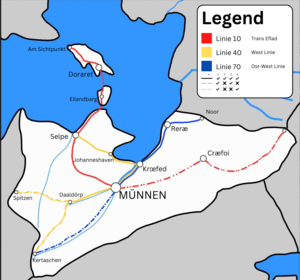
Research and development efforts form an integral part of the Efladian economy. In 2018 Eflad ranked fourth in the South Pacific in terms of number of science and engineering research papers published. Research institutions in Eflad include the Wolfgang Täuber Society, the Markus Association, the Küfer Society and the Holga Association.
Eflad is home to several large multinational corporations. The largest by revenue are Silvo, 3OP, RMA, SafeGuard, Deriva, Mlabo, Foelao, Juto i Rank and Riuk. Also, notable are Renko Bank, GabrielWealthManagement, CompU, T&B, SCM and Efladian Air Lines.
Infrastructure
With its position in extended Frastinia, Eflad is a transport hub for the region. Its rail network is on of the densest in Frastinia. The Express Line or EL train network serves major Efladian cities as well as destinations in neighbouring countries with speeds up to 300 km/h (190 mph). The largest Efladian airports are Münnen Int'l Airport and Selpe Airport. The Port of Doraret is one of the top twenty largest container ports in the world.
The government and the nuclear power industry agreed to phase out all nuclear power plants by 2030, however, the Tirng government announced that it will extend the use of nuclear power to bridge the time until renewable energies are developed. Eflad is one of the leaders in renewable energies, as it is the majority source of power with 45%. The country's household recycling rate is among the highest in the world—at around 65%. The Efladian energy transition (Energiewende) is the recognised move to a sustainable economy by means of energy efficiency and renewable energy.
Demographics
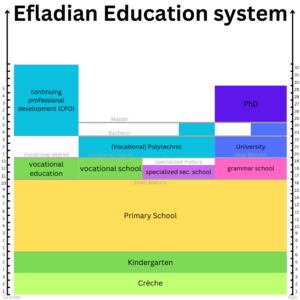
With a population of 54.2 million according to the 2015 Efladian Census, rising to 56.7 million as of 2020, Eflad is the third most populous country in the North Cordilian Union, the second-most populous country in Extended Frastinia after Besern, and fourteenth-most populous country in the South Pacific. Its population density stands at 327 inhabitants per square kilometer (847 per square mile). The fertility rate of 1.51 children born per woman (2022 estimates) is below the replacement rate of 1.8 and is one of the lowest fertility rates in the world. Since the 1990s, Eflad's death rate has exceeded its birth rate. However, Eflad is witnessing increased birth rates and migration rates since the beginning of the 2010s. There is a Besernian national minority in the northernmost province of Sweori, due to Besernian settlements. Of the country's residents, 10.7 million people (20.5%) were of immigrant or partially immigrant descent in 2016 (including persons descending or partially descending from ethnic Efladian repatriates). Eflad has a number of large cities. There are 4 officially recognised metropolitan regions. The country's largest city is Münnen.
Religion
According to the 2020 census, 68.3% respondents identified as non-religious/non-denominational 23.6% identified as Christian with 13.2% of those being Roman-Catholic and 10.1% as Protestants, including members of both the Evangelician Church and the Church of Evangelists. 0.3% are members of the Orthodox Church or other branches of Christianity. 8.9% are members of other religions. The high rate of atheists is due to the long period of state sanctioned atheism during the cold war under the socialist governments.
Education and science
Before 1976, education was organised by the provinces. In 1976, after a year of work by a scientific commission, education was nationalised. It has been unchanged since. Kindergarten education is provided for all children between three and six years old, after which school attendance is compulsory for at least ten years, ending in an kleine Matura. Secondary schooling is divided into tracks based on whether students pursue academic or vocational education. Academic secondary education is split into Fachoberschule - which lasts two years and ends with an Fachmatura - and the Gymnasium, which lasts three years and ends with an große Matura.
Most of the Efladian universities are public institutions, and students traditionally study without fee payment. The general requirement for attending university is the große Matura. However, a Fachmatura only entitles to attend the Fachhochschule (Polytechnic) and not the university. Eflad is home to several universities, such as the Dr. Herai Dofa University Münnen, Reræ University and the University of Selpe. The most prominent polytechnic is the Münnen Polytechnicum. Several universities also have polytechnic division which act as independent polytechnic schools.
Vocational education is divided into a sole vocational program and a mixed program. Students can either do a full apprenticeship (Berufsasubildung) and continue their career with further education, or they can associate their apprenticeship with an academic program (Berufsschule) after which they achieve a Berufsmatura, allowing them to go to a Berufsfachhochschule.
Health
Eflad uses a joint system of polyclinics and hospitals since the 1950s. Since then reforms and provisions have ensured a balanced health care system. The population is covered by a health insurance plan provided by statute, with criteria allowing some groups to opt for a private health insurance contract. In 2015, Eflad's health care system was 83% government-funded and 17% privately funded. In 2021, Eflad spent 14.6% of its GDP on health care.
The life expectancy is 74.1 years for men and 80.8 years for women according to the Efladian Health Statistics Organisation (EfHSO), and it had a very low infant mortality rate (4 per 1,000 live births). In 2019, the principal cause of death was cardiovascular disease, at 31% followed closely by obesity and its impacts. A study by the EfSHO in 2016 revealed that 48% of Efladians were overweight, with a very high rate of 39% among children.
Culture
Eflad is widely recognised as an influential state due to it being home to many key cultural figures. Eflads culture has been dominated by the Almans due to their colonial rule and the destruction of native Efladian culture. Eflad has been one of the countries on the border between several blocs in the Cold War. Some native traditions have been conserved, such as the annual festival of "Odnaplaz" where a giant chain of people is created on the beaches and at 15:30, everyone rushes into the sea, which is believed to cleanse the community of evil. Due to the majority of the population being atheists, there are no significant religious festivals or official religious holidays. However, during holidays of major religions, public life is often at a standstill.
Science and philosophy
Eflad was the home of numerous scientists with international reputation. Among them are Herai Dofa, Mark Hirsch, Paul Wilhelm Frei and Anton Mülle. A focus of Efladian science has always been physics and chemistry. Eminent chemists like Annalena Zohrn, Boris Keller and Ludolf Mitter have built upon the achievements of the 19th-century Münnen School of Chemistry. Many key discoveries in the fields of astro- and particle physics, as well as in the pharmaceutic and semiconductor industry were made in Eflad.
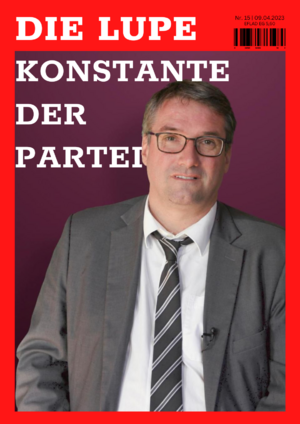
Philosophy enjoys high reputation in Eflad. It has been the birthplace of several famous philosophers such as Itwak Loig (16th Century), Wilhelm von Hohman, Leonhard Markus von Feldkirch, Thomas Holzstamm, Brigitte Chremer and many more. It's societal position resulted in the introduction of Philosophy as a subject in schools, replacing religious studies in 1979.
Literature
Eflad has produced only a handful of internationally known writers, such as Johann Turner. Efladian native literature mainly focused on local ghosts and spirits. After the colonisation of Eflad by Gianlucians, most of the native literature was destroyed by the ravages of libraries and book burning events. The most prominent Efladian authors are, amongst others, Alexander von Maurer, Wolfgang von Münnen, Franz Lüster, and Karl Pöller. Eflad has a high literacy rate because libraries are free and children are encouraged to read at an early age. International literary events include such things as the Münnen Book Fair and the Efladian Reading Championship.
Media
The two largest international media corporations are Hoffman Enterprise and Lorer RundFunk AG. Eflad's television market is one of the largest in northern Cordilia, with some 27 million TV households. Around 97% of Efladian households have cable or satellite TV, with a variety of free-to-view public and commercial channels. The high rate was achieved due to the massive projects undertaken by the socialist government in the 1970s. There are more than 150 public and private radio stations in Eflad; the official radio station of Eflad is Rundfunk Eflad. Eflad's print market of newspapers and magazines is one of the largest in northern Cordilia. The papers with the highest circulation are Das Morgenblatt, Münnener Zeitung, and Der Anzeiger. The largest magazines include Sonnenwelt and Die Lupe.
Cuisine
Efladian cuisine varies from region to region. Whereas in coastal areas it is mainly fish that is consumed, in the more rural regions it is rather cattle meat.

Beef is the most commonly eaten red meat, combined with vegetables it is usually served as a combined dish called Rindgemüse (Beef vegetables). Soup is an integral part of Efladian cuisine and is a part of almost all traditional Efladian menus. A big part of the daily meal is bread. Bakeries are very common throughout Eflad and fresh bread is a staple in every city, town and village. The most common product are small ellipsoid shaped bread portions called Schrippe. The most consumed drink is tea, especially green tea. Tea occupies a very important place in the Efladian culture and is considered an art form. It is served not only at mealtimes but all through the day, and it is especially a drink of hospitality, commonly served whenever there are guests. It is served to guests, and it is impolite to refuse it.
Sports
Eflad's most popular sport is football. The Efladian Football Association (EfFA) counts 3,6 million official members, and the highest Efladian league (Die 1. Liga) attracts millions of spectators every season. Karate has been the second-most popular sport since 1984. The Efladian Karate Federation has over 900 thousand members, more than tennis (250 thousand) in third place, with karate being more popular with the youth and tennis with the senior group.
Motor sport has been a large part of modern sports in Eflad. Companies like Trek Automobile are competing in several endurance races, e. g. the Izaakian Endurance Rally.
Waterpolo and windsurfing have been a part of coastal sports and culture. Eflad has a water polo league, which is one of the strongest in the world.


